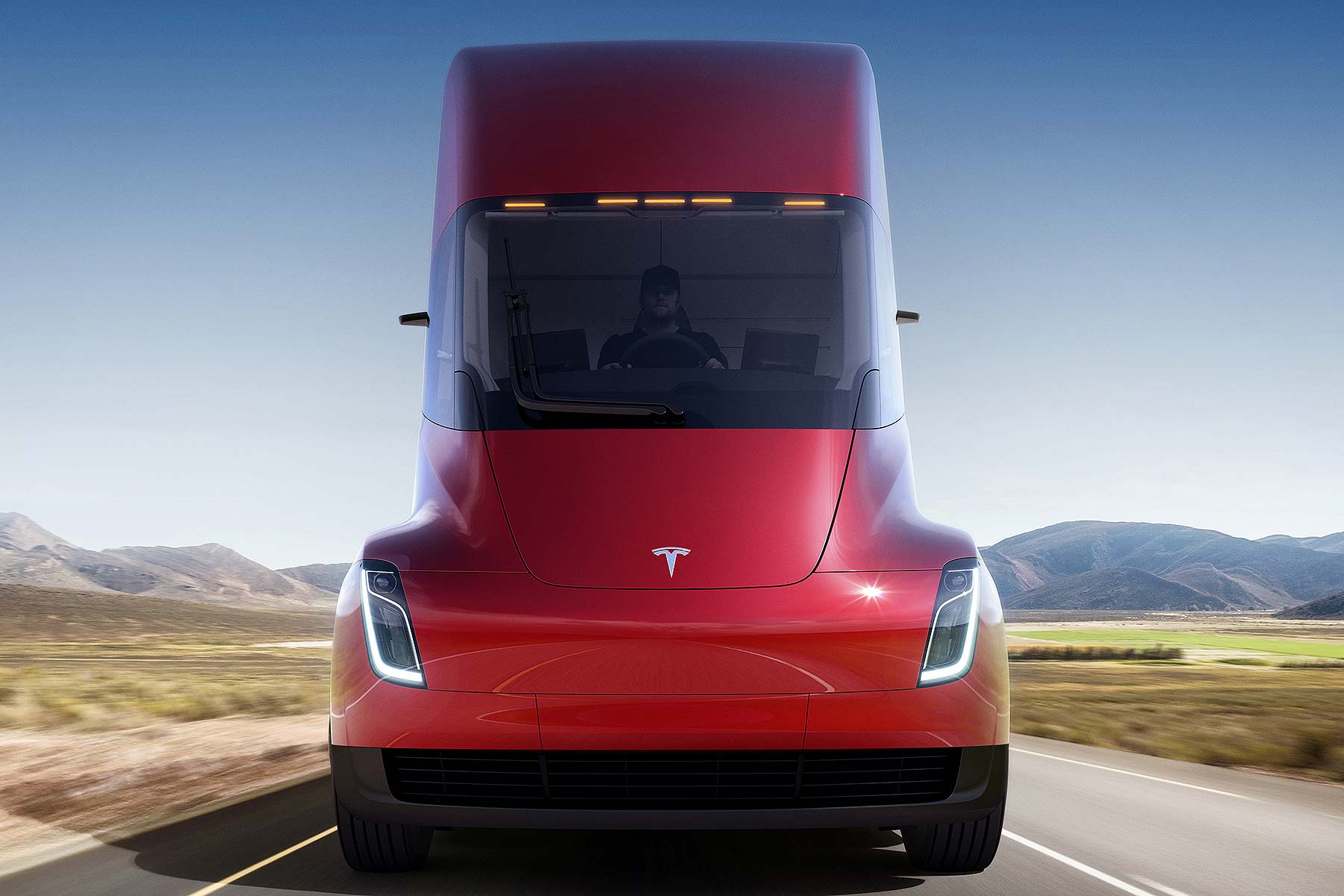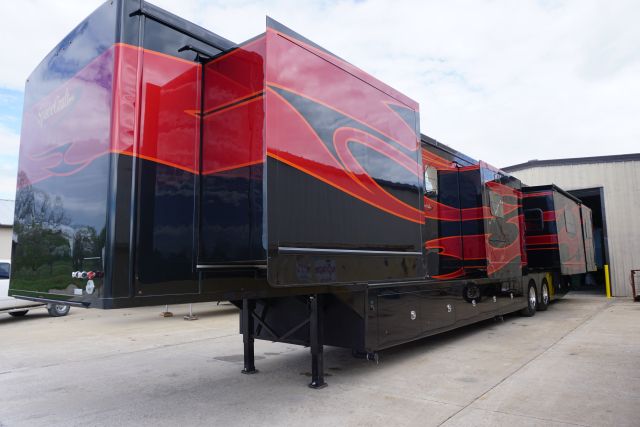- Good Sam Community
- Groups
- Travel Trailer Group
- Forum
- Re: Tesla Model X Towing 5,000-lb Camper: 600-Mile...
- Subscribe to RSS Feed
- Mark Topic as New
- Mark Topic as Read
- Float this Topic for Current User
- Bookmark
- Subscribe
- Mute
- Printer Friendly Page
Tesla Model X Towing 5,000-lb Camper: 600-Mile Road Trip
- Mark as New
- Bookmark
- Subscribe
- Mute
- Subscribe to RSS Feed
- Permalink
- Report Inappropriate Content
Jul-24-2020 05:52 AM
- Labels:
-
Tow Vehicles
- Mark as New
- Bookmark
- Subscribe
- Mute
- Subscribe to RSS Feed
- Permalink
- Report Inappropriate Content
Jul-31-2020 01:35 AM
time2roll wrote:RoyJ wrote:
Correct. C/5 would be drained over 5 hours
That is one very fast Semi to drain the 600 mile range battery in one hour...
OK climbing a hill or even accelerating could well be at the 1C rate for a short time. Although I believe this is all within design specification as long as the battery is kept within proper temperature range.
Where did I mention a semi drained the batt in 1 hour?
I specifically said high duty cycle applications are designed for C/5 to C/10 drain rates.
- Mark as New
- Bookmark
- Subscribe
- Mute
- Subscribe to RSS Feed
- Permalink
- Report Inappropriate Content
Jul-30-2020 01:36 PM
Reisender wrote:Rivian at up to 180 is the largest I know in a planned consumer vehicle.
I would think most SUV’s won’t see batteries bigger than 100 - 120 KWh and even vehicles like Cybertruck and Hummer won’t go much above 220-240 KWH. When they start to shoot for the 3/4 ton or 1 ton market that might change someday but I haven’t seen anything like that on the drawing board yet.
- Mark as New
- Bookmark
- Subscribe
- Mute
- Subscribe to RSS Feed
- Permalink
- Report Inappropriate Content
Jul-30-2020 01:33 PM
RoyJ wrote:
Correct. C/5 would be drained over 5 hours
That is one very fast Semi to drain the 600 mile range battery in one hour...
OK climbing a hill or even accelerating could well be at the 1C rate for a short time. Although I believe this is all within design specification as long as the battery is kept within proper temperature range.
- Mark as New
- Bookmark
- Subscribe
- Mute
- Subscribe to RSS Feed
- Permalink
- Report Inappropriate Content
Jul-30-2020 11:48 AM
RoyJ wrote:
My concern is the speed at which the pack is drained - nearly 1C. This is very hard on a big battery pack.
Batteries from lead acid to lithium are used in plenty of heavy duty applications, but they're sized for closer to C/4 to C/12 rates.
That's why I mentioned 1000 kWh - at that size, we could tow a regular commercial travel trailer and maintain say, a C/5 rate of discharge. Ideally you'd arrive at a campsite and charge overnight at C/10 rate. Not being blasted by a supercharger at 1C+
So far semi regular supercharging hasn’t had a big affect on Tesla batteries. Having said that most charging is fine at home sooooo...
I would think most SUV’s won’t see batteries bigger than 100 - 120 KWh and even vehicles like Cybertruck and Hummer won’t go much above 220-240 KWH. When they start to shoot for the 3/4 ton or 1 ton market that might change someday but I haven’t seen anything like that on the drawing board yet.
- Mark as New
- Bookmark
- Subscribe
- Mute
- Subscribe to RSS Feed
- Permalink
- Report Inappropriate Content
Jul-30-2020 11:30 AM
- Mark as New
- Bookmark
- Subscribe
- Mute
- Subscribe to RSS Feed
- Permalink
- Report Inappropriate Content
Jul-30-2020 11:27 AM
- Mark as New
- Bookmark
- Subscribe
- Mute
- Subscribe to RSS Feed
- Permalink
- Report Inappropriate Content
Jul-30-2020 11:14 AM
Batteries from lead acid to lithium are used in plenty of heavy duty applications, but they're sized for closer to C/4 to C/12 rates.
That's why I mentioned 1000 kWh - at that size, we could tow a regular commercial travel trailer and maintain say, a C/5 rate of discharge. Ideally you'd arrive at a campsite and charge overnight at C/10 rate. Not being blasted by a supercharger at 1C+
- Mark as New
- Bookmark
- Subscribe
- Mute
- Subscribe to RSS Feed
- Permalink
- Report Inappropriate Content
Jul-30-2020 06:25 AM
RoyJ wrote:
This hasn't been mentioned yet - but wonder if constant heavy discharge, followed by fast charging, will take a toll on battery life. Much more so than an IC engine running high duty cycle.
I'm far from anti-EV, in fact, I believe 99% (not an exaggeration) of commuting should be done with EVs.
But the fact is battery technology is not quite there yet to support heavy duty-cycle. The motors are, and have been ever since GM introduced the first diesel-electric locomotive. 99.9% of rail freight use electric motors for motive, the <.1% being heritage steamers.
As soon as we have reliable 1,000 kwh battery packs, with negligible Peukert factor, then bye-bye ICs.
It does, more so near fully charged or discharged. However, most users have home chargers that do overnight charging and I suspect that many commercial uses will do the same. Tesla seems to be less affected than other brands by battery degradation and is working hard on "million mile" batteries. That would probably mean around 80% of new capacity at one million miles. That is a lot of miles, even for a commercial vehicle. Speculation is that they are already there and are just saving the announcement to make the battery day presentation more exciting.
We should know in about 8 weeks.
- Mark as New
- Bookmark
- Subscribe
- Mute
- Subscribe to RSS Feed
- Permalink
- Report Inappropriate Content
Jul-30-2020 05:59 AM
- Mark as New
- Bookmark
- Subscribe
- Mute
- Subscribe to RSS Feed
- Permalink
- Report Inappropriate Content
Jul-30-2020 05:37 AM
RoyJ wrote:
This hasn't been mentioned yet - but wonder if constant heavy discharge, followed by fast charging, will take a toll on battery life. Much more so than an IC engine running high duty cycle.
I'm far from anti-EV, in fact, I believe 99% (not an exaggeration) of commuting should be done with EVs.
But the fact is battery technology is not quite there yet to support heavy duty-cycle. The motors are, and have been ever since GM introduced the first diesel-electric locomotive. 99.9% of rail freight use electric motors for motive, the <.1% being heritage steamers.
As soon as we have reliable 1,000 kwh battery packs, with negligible Peukert factor, then bye-bye ICs.
It’s a good question and I don’t know the answer. But judging by the amount of busses, mining equipment and grid storage being built I would think that at least some heavy duty deep cycling is supported.
There will be new info coming on Tesla’s battery day in September. Might be interesting.
- Mark as New
- Bookmark
- Subscribe
- Mute
- Subscribe to RSS Feed
- Permalink
- Report Inappropriate Content
Jul-29-2020 11:17 PM
I'm far from anti-EV, in fact, I believe 99% (not an exaggeration) of commuting should be done with EVs.
But the fact is battery technology is not quite there yet to support heavy duty-cycle. The motors are, and have been ever since GM introduced the first diesel-electric locomotive. 99.9% of rail freight use electric motors for motive, the <.1% being heritage steamers.
As soon as we have reliable 1,000 kwh battery packs, with negligible Peukert factor, then bye-bye ICs.
- Mark as New
- Bookmark
- Subscribe
- Mute
- Subscribe to RSS Feed
- Permalink
- Report Inappropriate Content
Jul-29-2020 03:19 PM
Me Again wrote:
All I can say about those 57' 5th wheel with the axles near the rear, one will have to learn to really swing their corner wide. There are many tight area that they will not go. Maybe the trailer wheels are steerable and the DW rides back there with a second steering wheel.
I have seen those up close and personal but usually in command and control operations or large mobile dental/medical clinics. Even movie production housing etc. An electric Tesla semi would work good in those situations.
- Mark as New
- Bookmark
- Subscribe
- Mute
- Subscribe to RSS Feed
- Permalink
- Report Inappropriate Content
Jul-29-2020 03:09 PM
- Mark as New
- Bookmark
- Subscribe
- Mute
- Subscribe to RSS Feed
- Permalink
- Report Inappropriate Content
Jul-27-2020 06:18 PM
qtla9111 wrote:8.1 Van wrote:
Here is what you will be able to tow next year with a Tesla .;)
Tesla Semi: the electric semi truck is going to be built in Texas
Do you have a link to this fifth wheel? Man that thing is huge!
Spacecraft RV Manufacturing 57 foot Custom 5th Wheel







